Orange Vaal River Yellowfish Conservation & Management Association (OVRYCMA) Telemetry Project
TELEMETRY PROJECT
The Vaal Orange largemouth yellowfish (Labeobarbus kimberleyensis) and the Vaal Orange smallmouth yellowfish (Labeobarbus aeneus) are endemic to the Orange Vaal River system. The former is recognised as being vulnerable according to the IUCN Red Data Listing process. The latter is under high angling pressure. Both species are sensitive to water pollution, habitat destruction and harvesting pressure. They are both noted as being great angling species while from a conservation point of view they have been identified as charismatic sensitive indicator species.
The study is therefore aimed at getting a better understanding of the behaviour of these two species in order to develop fisheries and habitat (river) management protocols that will enhance their survival and in so doing maintain a healthy ecosystem and a flourishing eco-tourism business. The study took place in a section of the Vaal River, which forms part of the overall Orange Vaal River catchments. The catchments covers Namibia, Botswana, South Africa and Lesotho. This will necessitate the development of management protocols in accordance with international standards.
MAIN AIMS OF THIS PROJECT:
· To determine the home ranges of the two species.
To determine how environmental variables (flooding, drawdown and temperature) affect the movement of these two species.
STUDY SITE
The study site was on a section of Vaal River below the Orkney weir and before the Bloemhof dam. This section was selected because there was serious commitment to yellowfish conservation and to the project by the landowner. At a specific place in this section of the river most of the work will be done as there is good yellowfish habitat and large numbers of specifically Largemouth yellowfish were caught on a regular basis in this area.
METHODS
Largemouth yellowfish over a fork length of 45 cm have been used while Smallmouth yellowfish over a fork length of 30 cm have been used. This ensured that fish were sexually active. No fish smaller than 1.5 kg should be tagged as the weight of the tag may impact on their behaviour. An autumn/winter (May to October) tagging period was planned and a spring/summer (September to March). A full time researcher carried out the tracking, reporting and documentation.
Species Distribution
L. Polylepis
Bushveld Smallscale
L. Marequensis
Lowveld Largescale
L. Kimberleyensis
Vaal-Orange Largemouth
L. Aeneus
Vaal-Orange Smallmouth
L. Natalensis
KwaZulu-Natal
L. Capensis
Clanwilliam
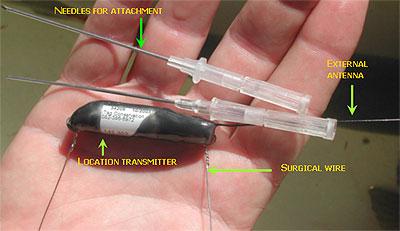
RESULTS OF INITIAL WORK
A single Largemouth yellowfish of 45 cm FL was tagged on the 06 December 2005 and was tracked on a daily basis until 05 January 2006. The floods that took place at this time prevented the team from tracking the fish as no boat could be launched. The fish remained within a home range of 200 to 300m. It showed specific short migrations during the day and night. It is assumed that these were associated with feeding regimes. The detailed study will verify the preliminary data
Some pictures of the Tagging process of the first Largemouth Yellowfish Tagged in this project
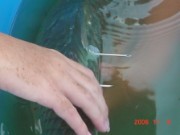
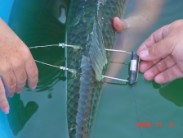
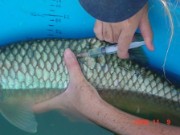
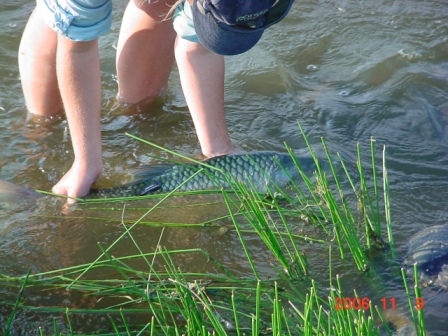
Catfish Joe Productions 2021 Copyright Protected, All rights reserved

